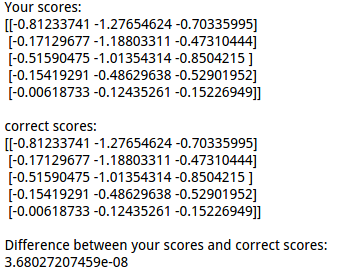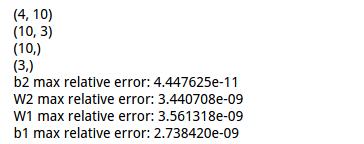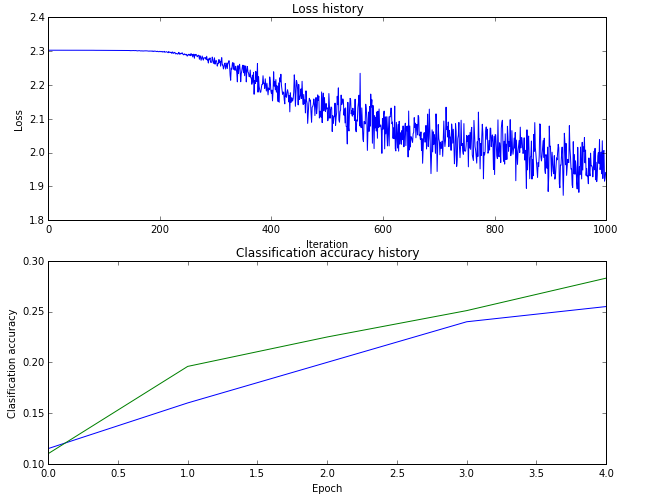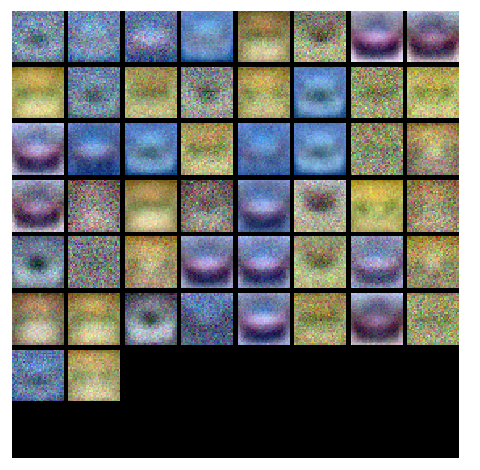CS231n 2016 通关 第四章-NN 作业
cell 1 显示设置初始化
# A bit of setup import numpy as np
import matplotlib.pyplot as plt from cs231n.classifiers.neural_net import TwoLayerNet %matplotlib inline
plt.rcParams['figure.figsize'] = (10.0, 8.0) # set default size of plots
plt.rcParams['image.interpolation'] = 'nearest'
plt.rcParams['image.cmap'] = 'gray' # for auto-reloading external modules
# see http://stackoverflow.com/questions/1907993/autoreload-of-modules-in-ipython
%load_ext autoreload
%autoreload 2 def rel_error(x, y):
""" returns relative error """
return np.max(np.abs(x - y) / (np.maximum(1e-8, np.abs(x) + np.abs(y))))
cell 2 网络模型与数据初始化函数
# Create a small net and some toy data to check your implementations.
# Note that we set the random seed for repeatable experiments. input_size = 4
hidden_size = 10
num_classes = 3
num_inputs = 5 def init_toy_model():
np.random.seed(0)
return TwoLayerNet(input_size, hidden_size, num_classes, std=1e-1) def init_toy_data():
np.random.seed(1)
X = 10 * np.random.randn(num_inputs, input_size)
y = np.array([0, 1, 2, 2, 1])
return X, y net = init_toy_model()
X, y = init_toy_data()
通过末尾的调用,生成了NN类,并生成了测试数据。
类的初始化代码(cs231n/classifiers/neural_net.py):
def __init__(self, input_size, hidden_size, output_size, std=1e-4):
"""
Initialize the model. Weights are initialized to small random values and
biases are initialized to zero. Weights and biases are stored in the
variable self.params, which is a dictionary with the following keys: W1: First layer weights; has shape (D, H)
b1: First layer biases; has shape (H,)
W2: Second layer weights; has shape (H, C)
b2: Second layer biases; has shape (C,) Inputs:
- input_size: The dimension D of the input data.
- hidden_size: The number of neurons H in the hidden layer.
- output_size: The number of classes C.
"""
self.params = {}
self.params['W1'] = std * np.random.randn(input_size, hidden_size)
self.params['b1'] = np.zeros(hidden_size)
self.params['W2'] = std * np.random.randn(hidden_size, output_size)
self.params['b2'] = np.zeros(output_size)
cell 3 前向传播计算loss,得到的结果与参考结果对比,证明模型的正确性:
scores = net.loss(X)
print 'Your scores:'
print scores
print 'correct scores:'
correct_scores = np.asarray([
[-0.81233741, -1.27654624, -0.70335995],
[-0.17129677, -1.18803311, -0.47310444],
[-0.51590475, -1.01354314, -0.8504215 ],
[-0.15419291, -0.48629638, -0.52901952],
[-0.00618733, -0.12435261, -0.15226949]])
print correct_scores # The difference should be very small. We get < 1e-7
print 'Difference between your scores and correct scores:'
print np.sum(np.abs(scores - correct_scores))
结果对比:

loss function 代码:
def loss(self, X, y=None, reg=0.0):
"""
Compute the loss and gradients for a two layer fully connected neural
network. Inputs:
- X: Input data of shape (N, D). Each X[i] is a training sample.
- y: Vector of training labels. y[i] is the label for X[i], and each y[i] is
an integer in the range 0 <= y[i] < C. This parameter is optional; if it
is not passed then we only return scores, and if it is passed then we
instead return the loss and gradients.
- reg: Regularization strength. Returns:
If y is None, return a matrix scores of shape (N, C) where scores[i, c] is
the score for class c on input X[i]. If y is not None, instead return a tuple of:
- loss: Loss (data loss and regularization loss) for this batch of training
samples.
- grads: Dictionary mapping parameter names to gradients of those parameters
with respect to the loss function; has the same keys as self.params.
"""
# Unpack variables from the params dictionary
W1, b1 = self.params['W1'], self.params['b1']
W2, b2 = self.params['W2'], self.params['b2']
#5 *4
N, D = X.shape
num_train = N
# Compute the forward pass
scores = None
#############################################################################
# TODO: Perform the forward pass, computing the class scores for the input. #
# Store the result in the scores variable, which should be an array of #
# shape (N, C). #
#############################################################################
#5*4 * 4*10 >>>5*10
buf_H = np.dot(X,W1) + b1
#RELU
buf_H[buf_H<0] = 0
#5*10 * 10 *3 >>>5*3
buf_O=np.dot(buf_H,W2) + b2
scores = buf_O
#############################################################################
# END OF YOUR CODE #
############################################################################# # If the targets are not given then jump out, we're done
if y is None:
return scores # Compute the loss
loss = None
#############################################################################
# TODO: Finish the forward pass, and compute the loss. This should include #
# both the data loss and L2 regularization for W1 and W2. Store the result #
# in the variable loss, which should be a scalar. Use the Softmax #
# classifier loss. So that your results match ours, multiply the #
# regularization loss by 0.5 #
#############################################################################
scores = np.subtract( scores.T , np.max(scores , axis = 1) ).T
scores = np.exp(scores)
scores = np.divide( scores.T , np.sum(scores , axis = 1) ).T
loss = - np.sum(np.log ( scores[np.arange(num_train),y] ) ) / num_train
loss += 0.5 * reg * (np.sum(W1*W1) + np.sum(W2*W2) )
#############################################################################
# END OF YOUR CODE #
############################################################################# # Backward pass: compute gradients
grads = {}
#############################################################################
# TODO: Compute the backward pass, computing the derivatives of the weights #
# and biases. Store the results in the grads dictionary. For example, #
# grads['W1'] should store the gradient on W1, and be a matrix of same size #
#############################################################################
#get grad
scores[np.arange(num_train),y] -= 1
# 10 *5 * 5*3 >>>10*3
dW2 = np.dot(buf_H.T,scores)/num_train + reg*W2
#
db2 = np.sum(scores,axis =0)/num_train
#10 * 3 * 3 *5 >>10 * 5
buf_hide = np.dot(W2,scores.T)
#element > 0
buf_H[buf_H>0] = 1
#relu buf_hide
buf_relu = buf_hide.T * buf_H
#4*5 * 5*10 >>4*10
dW1 = np.dot(X.T,buf_relu) /num_train + reg*W1
#
db1 = np.sum(buf_relu,axis =0) /num_train
grads['W1'] = dW1
grads['W2'] = dW2
grads['b1'] = db1
grads['b2'] = db2
#############################################################################
# END OF YOUR CODE #
############################################################################# return loss, grads
cell 4 计算包含正则的loss
loss, _ = net.loss(X, y, reg=0.1)
correct_loss = 1.30378789133 # should be very small, we get < 1e-12
print loss
print 'Difference between your loss and correct loss:'
print np.sum(np.abs(loss - correct_loss))
结果:

cell 5 反向传播,并用数值法来验证偏导的正确性》》注意使用链式法则:
from cs231n.gradient_check import eval_numerical_gradient # Use numeric gradient checking to check your implementation of the backward pass.
# If your implementation is correct, the difference between the numeric and
# analytic gradients should be less than 1e-8 for each of W1, W2, b1, and b2. loss, grads = net.loss(X, y, reg=0.1)
print grads['W1'].shape
print grads['W2'].shape
print grads['b1'].shape
print grads['b2'].shape
# these should all be less than 1e-8 or so
for param_name in grads:
f = lambda W: net.loss(X, y, reg=0.1)[0]
param_grad_num = eval_numerical_gradient(f, net.params[param_name], verbose=False)
print '%s max relative error: %e' % (param_name, rel_error(param_grad_num, grads[param_name]))
显示解析法与数值法的结果差异:

cell 6 训练网络模型。在loss grad 计算无误的基础上,使用对应的函数方法来训练模型。
net = init_toy_model()
#two layers net
stats = net.train(X, y, X, y,
learning_rate=1e-1, reg=1e-5,
num_iters=100, verbose=False) print 'Final training loss: ', stats['loss_history'][-1] # plot the loss history
plt.plot(stats['loss_history'])
plt.xlabel('iteration')
plt.ylabel('training loss')
plt.title('Training Loss history')
plt.show()
训练函数代码:
def train(self, X, y, X_val, y_val,
learning_rate=1e-3, learning_rate_decay=0.95,
reg=1e-5, num_iters=100,
batch_size=200, verbose=False):
"""
Train this neural network using stochastic gradient descent. Inputs:
- X: A numpy array of shape (N, D) giving training data.
- y: A numpy array f shape (N,) giving training labels; y[i] = c means that
X[i] has label c, where 0 <= c < C.
- X_val: A numpy array of shape (N_val, D) giving validation data.
- y_val: A numpy array of shape (N_val,) giving validation labels.
- learning_rate: Scalar giving learning rate for optimization.
- learning_rate_decay: Scalar giving factor used to decay the learning rate
after each epoch.
- reg: Scalar giving regularization strength.
- num_iters: Number of steps to take when optimizing.
- batch_size: Number of training examples to use per step.
- verbose: boolean; if true print progress during optimization.
"""
num_train = X.shape[0]
iterations_per_epoch = max(num_train / batch_size, 1) # Use SGD to optimize the parameters in self.model
loss_history = []
train_acc_history = []
val_acc_history = [] for it in xrange(num_iters):
X_batch = None
y_batch = None #########################################################################
# TODO: Create a random minibatch of training data and labels, storing #
# them in X_batch and y_batch respectively. #
#########################################################################
if batch_size > num_train:
mask = np.random.choice(num_train, batch_size, replace=True)
else :
mask = np.random.choice(num_train, batch_size, replace=False)
X_batch = X[mask]
y_batch = y[mask]
#########################################################################
# END OF YOUR CODE #
######################################################################### # Compute loss and gradients using the current minibatch
loss, grads = self.loss(X_batch, y=y_batch, reg=reg)
loss_history.append(loss) #########################################################################
# TODO: Use the gradients in the grads dictionary to update the #
# parameters of the network (stored in the dictionary self.params) #
# using stochastic gradient descent. You'll need to use the gradients #
# stored in the grads dictionary defined above. #
#########################################################################
self.params['W1'] = self.params['W1'] - learning_rate * grads['W1']
self.params['b1'] = self.params['b1'] - learning_rate * grads['b1']
self.params['W2'] = self.params['W2'] - learning_rate * grads['W2']
self.params['b2'] = self.params['b2'] - learning_rate * grads['b2']
#########################################################################
# END OF YOUR CODE #
######################################################################### if verbose and it % 100 == 0:
print 'iteration %d / %d: loss %f' % (it, num_iters, loss) # Every epoch, check train and val accuracy and decay learning rate.
if it % iterations_per_epoch == 0:
# Check accuracy
train_acc = (self.predict(X_batch) == y_batch).mean()
val_acc = (self.predict(X_val) == y_val).mean()
train_acc_history.append(train_acc)
val_acc_history.append(val_acc) # Decay learning rate
learning_rate *= learning_rate_decay return {
'loss_history': loss_history,
'train_acc_history': train_acc_history,
'val_acc_history': val_acc_history,
}
显示最终的training loss以及绘制下降曲线:

之前都是使用比较简单的数据进行计算,接下来对cifar-10进行分类。
cell 7 载入训练和测试数据集,并显示各数据的维度:
from cs231n.data_utils import load_CIFAR10 def get_CIFAR10_data(num_training=49000, num_validation=1000, num_test=1000):
"""
Load the CIFAR-10 dataset from disk and perform preprocessing to prepare
it for the two-layer neural net classifier. These are the same steps as
we used for the SVM, but condensed to a single function.
"""
# Load the raw CIFAR-10 data
cifar10_dir = 'cs231n/datasets/cifar-10-batches-py'
X_train, y_train, X_test, y_test = load_CIFAR10(cifar10_dir) # Subsample the data
mask = range(num_training, num_training + num_validation)
X_val = X_train[mask]
y_val = y_train[mask]
mask = range(num_training)
X_train = X_train[mask]
y_train = y_train[mask]
mask = range(num_test)
X_test = X_test[mask]
y_test = y_test[mask] # Normalize the data: subtract the mean image
mean_image = np.mean(X_train, axis=0)
X_train -= mean_image
X_val -= mean_image
X_test -= mean_image # Reshape data to rows
X_train = X_train.reshape(num_training, -1)
X_val = X_val.reshape(num_validation, -1)
X_test = X_test.reshape(num_test, -1) return X_train, y_train, X_val, y_val, X_test, y_test # Invoke the above function to get our data.
X_train, y_train, X_val, y_val, X_test, y_test = get_CIFAR10_data()
print 'Train data shape: ', X_train.shape
print 'Train labels shape: ', y_train.shape
print 'Validation data shape: ', X_val.shape
print 'Validation labels shape: ', y_val.shape
print 'Test data shape: ', X_test.shape
print 'Test labels shape: ', y_test.shape
结果显示:

cell 8 初始化网络并进行训练:
input_size = 32 * 32 * 3
hidden_size = 50
num_classes = 10
net = TwoLayerNet(input_size, hidden_size, num_classes) # Train the network
stats = net.train(X_train, y_train, X_val, y_val,
num_iters=1000, batch_size=200,
learning_rate=1e-4, learning_rate_decay=0.95,
reg=0.5, verbose=True) # Predict on the validation set
val_acc = (net.predict(X_val) == y_val).mean()
print 'Validation accuracy: ', val_acc
上述代码对验证集进行了预测,得到的准确率:

预测代码:
def predict(self, X):
"""
Use the trained weights of this two-layer network to predict labels for
data points. For each data point we predict scores for each of the C
classes, and assign each data point to the class with the highest score. Inputs:
- X: A numpy array of shape (N, D) giving N D-dimensional data points to
classify. Returns:
- y_pred: A numpy array of shape (N,) giving predicted labels for each of
the elements of X. For all i, y_pred[i] = c means that X[i] is predicted
to have class c, where 0 <= c < C.
"""
W1, b1 = self.params['W1'], self.params['b1']
W2, b2 = self.params['W2'], self.params['b2']
y_pred = None #5*10 * 10 *3 >>>5*3
###########################################################################
# TODO: Implement this function; it should be VERY simple! #
###########################################################################
layer_hide = np.dot(X,W1) + b1
layer_hide[layer_hide<0] = 0
layer_soft = np.dot(layer_hide,W2) + b2
scores = np.subtract( layer_soft.T , np.max(layer_soft , axis = 1) ).T
scores = np.exp(scores)
scores = np.divide( scores.T , np.sum(scores , axis = 1) ).T
y_pred = np.argmax(scores , axis = 1)
###########################################################################
# END OF YOUR CODE #
########################################################################### return y_pred
接下来,对网络模型进行一些调试,观察结果。
cell 9 绘制train集的loss以及train集的准确率与validation集的准确率:
# Plot the loss function and train / validation accuracies
plt.subplot(2, 1, 1)
plt.plot(stats['loss_history'])
plt.title('Loss history')
plt.xlabel('Iteration')
plt.ylabel('Loss') plt.subplot(2, 1, 2)
plt.plot(stats['train_acc_history'], label='train')
plt.plot(stats['val_acc_history'], label='val')
plt.title('Classification accuracy history')
plt.xlabel('Epoch')
plt.ylabel('Clasification accuracy')
plt.show()
绘制的图形曲线:

cell 10 对w的分量分别进行可视化:
from cs231n.vis_utils import visualize_grid # Visualize the weights of the network def show_net_weights(net):
W1 = net.params['W1']
W1 = W1.reshape(32, 32, 3, -1).transpose(3, 0, 1, 2)
plt.imshow(visualize_grid(W1, padding=3).astype('uint8'))
plt.gca().axis('off')
plt.show() show_net_weights(net)
结果:

接着是通过验证的方式选取超参数,包括:隐藏层的结点数、学习率、正则化强度系数。
cell 11 选取超参数,没有对正则化强度系数及其衰减系数进行选取:
best_net = None # store the best model into this
best_val = 0
#################################################################################
# TODO: Tune hyperparameters using the validation set. Store your best trained #
# model in best_net. #
# #
# To help debug your network, it may help to use visualizations similar to the #
# ones we used above; these visualizations will have significant qualitative #
# differences from the ones we saw above for the poorly tuned network. #
# #
# Tweaking hyperparameters by hand can be fun, but you might find it useful to #
# write code to sweep through possible combinations of hyperparameters #
# automatically like we did on the previous exercises. #
#################################################################################
input_size = 32 * 32 * 3
Hidden_size = [50 ,64,128]
REG = [0.01,0.1,0.5]
num_classes = 10
for i in Hidden_size:
for j in REG :
net = TwoLayerNet(input_size, i, num_classes)
# Train the network
stats = net.train(X_train, y_train, X_val, y_val,
num_iters=2000, batch_size=200,
learning_rate=1e-3, learning_rate_decay=0.95,
reg = j, verbose=False)
val_acc = (net.predict(X_val) == y_val).mean()
print 'Validation accuracy: ', val_acc
if best_val < val_acc:
best_val = val_acc
best_net = net
#################################################################################
# END OF YOUR CODE #
#################################################################################
显示各个参数的验证集准确率结果:

cell 12 可视化最优参数对应模型的隐藏层结点对应的w的结果:
# visualize the weights of the best network
show_net_weights(best_net)
结果:

cell 13 使用最优参数模型对测试集进行预测:
test_acc = (best_net.predict(X_test) == y_test).mean()
print 'Test accuracy: ', test_acc
得到的结果:

附:通关CS231n企鹅群:578975100 validation:DL-CS231n
CS231n 2016 通关 第四章-NN 作业的更多相关文章
- CS231n 2016 通关 第四章-反向传播与神经网络(第一部分)
在上次的分享中,介绍了模型建立与使用梯度下降法优化参数.梯度校验,以及一些超参数的经验. 本节课的主要内容: 1==链式法则 2==深度学习框架中链式法则 3==全连接神经网络 =========== ...
- CS231n 2016 通关 第三章-Softmax 作业
在完成SVM作业的基础上,Softmax的作业相对比较轻松. 完成本作业需要熟悉与掌握的知识: cell 1 设置绘图默认参数 mport random import numpy as np from ...
- CS231n 2016 通关 第三章-SVM 作业分析
作业内容,完成作业便可熟悉如下内容: cell 1 设置绘图默认参数 # Run some setup code for this notebook. import random import nu ...
- CS231n 2016 通关 第六章 Training NN Part2
本章节讲解 参数更新 dropout ================================================================================= ...
- CS231n 2016 通关 第五章 Training NN Part1
在上一次总结中,总结了NN的基本结构. 接下来的几次课,对一些具体细节进行讲解. 比如激活函数.参数初始化.参数更新等等. ====================================== ...
- CS231n 2016 通关 第三章-SVM与Softmax
1===本节课对应视频内容的第三讲,对应PPT是Lecture3 2===本节课的收获 ===熟悉SVM及其多分类问题 ===熟悉softmax分类问题 ===了解优化思想 由上节课即KNN的分析步骤 ...
- CS231n 2016 通关 第五、六章 Fully-Connected Neural Nets 作业
要求:实现任意层数的NN. 每一层结构包含: 1.前向传播和反向传播函数:2.每一层计算的相关数值 cell 1 依旧是显示的初始设置 # As usual, a bit of setup impor ...
- CS231n 2016 通关 第二章-KNN 作业分析
KNN作业要求: 1.掌握KNN算法原理 2.实现具体K值的KNN算法 3.实现对K值的交叉验证 1.KNN原理见上一小节 2.实现KNN 过程分两步: 1.计算测试集与训练集的距离 2.通过比较la ...
- CS231n 2016 通关 第五、六章 Dropout 作业
Dropout的作用: cell 1 - cell 2 依旧 cell 3 Dropout层的前向传播 核心代码: train 时: if mode == 'train': ############ ...
随机推荐
- JavaScript插件编写指南
在编写插件之前,大家要先了解做插件的几个要点: 插件需要满足的条件 一个可复用的插件需要满足以下条件: 插件自身的作用域与用户当前的作用域相互独立,也就是插件内部的私有变量不能影响使用者的环境变量: ...
- caffe搭建--opensuse13.2上搭建caffe开发环境
第一部分:参考一下内容.将sudo 替换成zypper即可. --------------------------------------------这部分参照以下官网内容-------------- ...
- Canvas学习笔记——弹动
如果有一根橡皮筋拴住一个小球,将小球拉开一定距离后释放,小球将会弹动.距离越远,橡皮筋对小球施加的外力越大,小球的加速度就越大.也就是说,小球的加速度与距离是成正比例关系的.这和缓动很相似,缓动是速度 ...
- 神经网络实现Discuz验证码识别
最近自己尝试了网上的验证码识别代码项目,该小项目见以下链接: https://cuijiahua.com/blog/2018/01/dl_5.html 数据也就用了作者上传的60000张Discuz验 ...
- 如何清除本地DNS缓存 windows
在您的网站迁移服务器时需要对域名所指向的IP进行更改,这时候在本机访问网站时就需要清除本地的DNS缓存信息,那么怎样清除呢? 首先我们应该明白清除DNS缓存信息的原理:当计算机对域名访问时并不是每次访 ...
- apktool + eclipse 动态调试APK
用了会AndBug,尽管挺强大的可是作为习惯了OD.EDB作为动态调试工具的人,自然有些不习惯,于是乎寻求新的动态调试解决方式.但大多数都是NetBeans + apktool.想着还得多下一个IDE ...
- 关于js开发的小问题
一.开发当中经常会动态拼接html,当然为了简便性好多人直接就是使用内联事件: $('#td1').html( '<a href="#" onclick="app. ...
- win10获取注册表权限
1.cmd中输入regedit打开注册表 2.在需要的注册表项中右键选择“权限”
- asp.net mvc4 之Webapi之应用客户端访问服务器端
一.说明 客户端项目类型设计为:winform(winform窗体项目类型) 服务器端项目类型设计为:asp.net mvc4 webapi 在这里分为项目运行和调试两种情况讨论: 运行: 这种情况 ...
- 九度OJ 1087:约数的个数 (数字特性)
时间限制:1 秒 内存限制:32 兆 特殊判题:否 提交:7349 解决:2306 题目描述: 输入n个整数,依次输出每个数的约数的个数 输入: 输入的第一行为N,即数组的个数(N<=1000) ...
